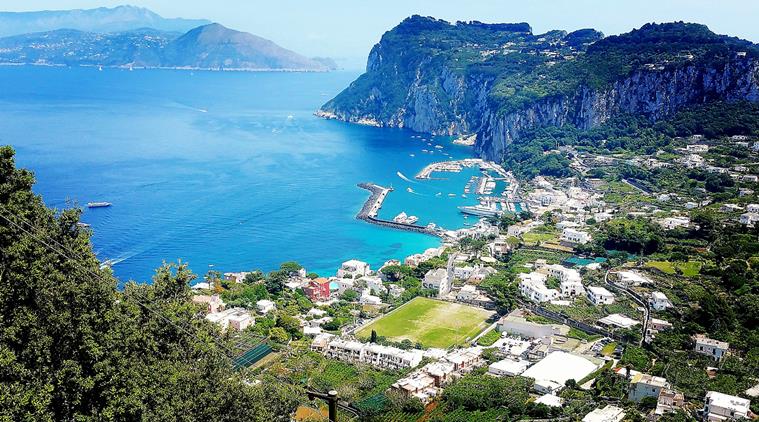Crystal blue persuasion
Its skies immensely blue and the waters impossibly turquoise, Capri is a curious mix of history and glamour.
 Capri from Scala Fenicia.
Capri from Scala Fenicia.
A thousand-year-old pathway unfolded before us. Through the ancient Greek quarter of Capri, with its maze of whitewashed houses, lemon gardens and small vineyards, we walked under an unrelenting sun. A wall of craggy cliffs loomed ahead of us and my husband, squinting in the harsh glare of the sun, espied a carriageway zigzagging its way up. “This is not happening. We are not climbing all the way up,” he stated with some vehemence. Then, he proceeded to stand in the middle of the path and refused to budge. “Okay then, I shall carry on and you better make your way back to the bus stop. Wait two hours till that small rickety bus, overstuffed with tourists, brings you up,” I retorted in exasperation.
I was not exaggerating. We had been in a winding queue when I first saw the orange bus for Anacapri arrive in the Marina Grande and fill up with more people than it could hold. It was not a pretty sight. Taxis were an equally hopeless prospect — the queues were even longer.
A deep scowl and a few mumblings later, the husband started following me up the path that took us into a stretch of woods with gentle steps, which soon graduated to steep ones. We were on the famed Scala Fenicia trail. The Phoenician Steps are named after the Phoenicians but were built by the Greeks, the first recorded colonisers of Capri. Women from Capri, apparently much appreciated for their beauty by the early travellers, painstakingly built the steps, which was the only way linking Capri and Anacapri. That was until 1877, when the vertiginous carriageway was built.
The sky was immensely blue, the waters impossibly turquoise and the heat unbearable when we reached the island of Capri, in the Tyrrhenian Sea, and off the Sorrentine peninsula of Italy. As a school girl, Capri had often occupied my imagination. We had a short story by W Somerset Maugham in our curriculum — The Lotus Eaters — in which a bank manager from London arrives in Capri for a summer holiday. There’s no turning back for him when he sets his eyes upon the limestone sea stacks of Il Faraglioni, “those two great rocks sticking out of the water, with the moon above them, and all the little lights of the fishermen in their boats catching cuttlefish, all so peaceful and beautiful…” He wonders to himself, “Well, after all, why should I go back?” He lives a lotus-eating existence thereafter, but the ending always gives me the heebie-jeebies. Since then, Capri, in my mind, has been the island of lotus eaters. The copious number of them on the island was a rude shock, but the Capri of my imagination came to life only once the sun set and the day-trippers left the island.
But before that, we left our baggage at the luggage storage on Marina Grande, one of the two harbours in Capri, and decided upon an escape. It took us to the commune of Anacapri that stands high above Capri, upon the slopes of Monte Solaro.
When we reached Anacapri, in a matter of 921 punishing steps, it was a different world up there. It was hard to imagine the locals charting those steps every day to get their supply of drinking water from the spring in the Marina Grande. Swedish doctor Axel Munthe, who once lived in Anacapri, had made a note about Anacapri’s postal officer in his book, The Story of San Michele. She climbed up and down the steps every day to collect letters and parcels from Capri. For us, the reward of the climb was the breathtaking view over Capri, along with the tiny chapel on the path dedicated to Sant’Antonio of Padua, the patron saint of Anacapri.
 A beach in Capri.
A beach in Capri.
Atop the steps was Munthe’s Villa San Michele, which took 20 long years to construct, with building material hauled up the Phoenician Steps by donkeys and men. “My home shall be open for the sun and the wind and the voices of the sea — like a Greek temple — and light, light, light everywhere!” wrote Munthe in The Story of San Michele. It still remains a coveted spot in Anacapri, which, in ancient times, had an imperial Roman villa and a medieval chapel.
By this time, the sun was beating down strongly and the heat meant that we had to resuscitate ourselves with the icy goodness of lemon granita before we could hop onto the chair-lift to glide up to the 600 m summit of Monte Solaro, passing over patches of vegetable gardens. From atop the mountain, I stared at the Il Faraglioni jutting out from the inky blue waters and day dreamed of The Lotus Eaters. In the vicinity of the limestone stacks is another famous landmark of Capri — the Blue Grotto, a natural sea cave with iridescent blue lights in its interiors.
Now, Anacapri is wonderfully quiet. It has a small network of clothes boutiques, Neapolitan tailors and perfumeries that are bustling. I quite fell in love with the citrus fragrances in those perfumeries but contented myself with a big cone of ice cream instead.
Wholly committed to the cause of finishing the ice as it melted fast in the heat, we descended to Capri via the Phoenician Steps and, with trembling legs, caught our breath at the piazzetta in its heart. A resort ever since Emperor Augustus landed there, Capri has a glitzy air about it. You can easily put a finger upon the atmosphere that might have been induced by the many emperors in the past or the brigades of film stars and the fashion icons who have been its dedicated patrons. We had a glimpse of that world when we sat at the marina, watching the boats come in and leave. We watched old men with tanned bodies on their boats who could have passed off for playboys, but then we chanced upon the sight of a bejewelled woman get off a boat and dish out autographs to a few people. All of the clichéd notions of Capri came to life at that moment.
Arundhati Basu is a freelance writer and blogger who lives in Northampton, UK, and likes to be on the move whenever possible.



- 01
- 02
- 03
- 04
- 05
























